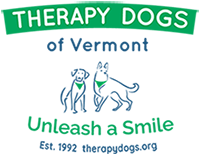—Isa Helfrich, German Shepherd & therapy dog (and Deb Helfrich, Vice President)
QUESTION: I’ve been on quite a few teams over the years. On this latest team I’m on, there’s lots of rough housing among the dogs while we’re working. The other dogs sniff my butt, nose my face, and try to play with me while I’m visiting. The last team I worked on was on was pretty rigid—no dogging around! What’s your take on etiquette for dogs working in teams? – Trick, the Corgi
ANSWER: Now, I like a good tushie sniff as much as the next canine, but work is work, play is play. I love romping with my therapy dog friends Dieter the Lab and Moxy the Retriever—but there’s a time and place for it (especially since I am LOUD when I play…bark bark bark!). I’m not poo-pooing a reassuring nose touch or sniff between teammates in the hallway between visits. Nor am I saying therapy dogs can’t interact at all on duty—some teams even do tricks together. And, I’m not saying teams should operate like a military unit. However, when we’ve got those bandannas on and we’re working with our patients, we’re professionals, focused on the people we’re visiting. A few things to consider:
- A distinction between work and play helps me understand how I am expected to behave while working. When my TDV bandanna goes on, I know that barking, romping, butt sniffing, and such should be saved for later. My handler says “working now” when she puts on my purple bandanna—and I get so excited that I’m going to see all my friends at the nursing home—and I know that I’m on my best behavior (at least until someone pulls out a hotdog or a frisbee—then I may forget for a minute!). Likewise, when my handler takes off the bandanna and says “All Done!” I know I can cut loose!
- A “we’re working now” attitude helps me concentrate on the therapy dog visit. My focus is on the people I’m visiting, not my buddies. It’s tough to concentrate on a sweet elder lady who is patting my nose when my teammate is sniffing my butt or trying to get me to play.
- Public Perception. What sort of impression would it leave for a team of therapy dogs, all clean and freshly brushed, decked out in their bandanas and badges—to be seen romping and hooting like a pack of hyenas? Well, you get the idea!
- Safety and politeness. Even though therapy dogs have been tested for aggression problems towards other dogs, dogs can’t verbalize like a human and say politely, “ahem, would you please remove your proboscis from my posterior?” Instead, they may feel that they have to growl or raise a lip to warn a rude teammate to give some space. Even though this may be dog communication, it is not what we want a therapy dog to do on duty. So, your handler should be sure that you aren’t forgetting your manners by being rude or distracting to a dog who is working with a person. Likewise, if you are the one being subjected to a pushy, rude, or playful dog, your handler should take care of the situation by moving you away from the other dog or asking the handler to be more conscious. Likewise, a dog getting a treat, or playing with a toy with a favorite patient may feel a bit jealous or threatened by a teammate getting too close and butting in on the action.
Visiting on teams is a great way to have fun while volunteering with your dog. Just remember to be safe, give space, and be professional!
“Ask Isa” is a Q&A column appearing in the Therapy Dogs of Vermont quarterly newsletter. It is reproduced here for Therapy Dogs of Vermont website readers. It is not a substitute for seeking proper veterinary, training, or behavioral advice from professionals!
